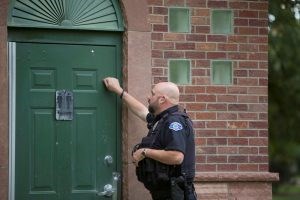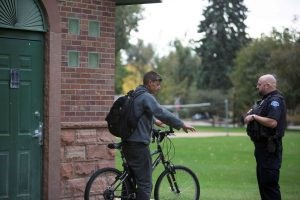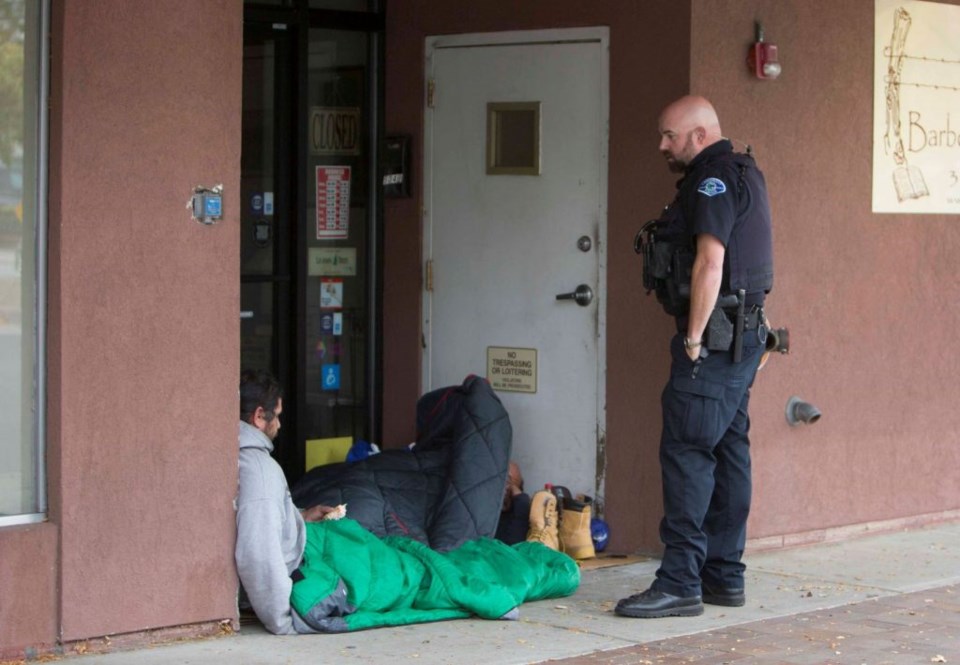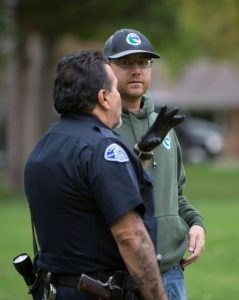This content was originally published by the Longmont Observer and is licensed under a Creative Commons license.
This is the third in a series of five articles about homelessness. It is based on an interview with the Public Safety Chief Mike Butler and police Deputy Chief Jeff Satur. The article focuses on homelessness from the perspective of public safety and law enforcement.

Satur noted that the amount of resources devoted to homelessness is increasing. Police used to be able to count the number of homeless in Longmont on one hand. Now they are seeing between 350 and 400 people per year.
However, it should be noted that the police department and public safety do not survey the homeless population. Although other groups in Longmont do survey the homeless population, most of the information the police and public safety have comes from police reports and calls for service. The police and public safety deal with both non-local homeless and long-time Longmont homeless populations.
Butler notes that although the police and public safety do have negative interactions with the homeless because they get called out to help when behavior is an issue, there are also positive interactions. Just recently, an award was given to officer Chrystie Wheeler for helping a homeless man who had a brain tumor get the medical help he needed. He is now reunited with his family.


The Angel Initiative is another area where interactions with the homeless are positive. In this case, a person has asked for help getting back on their feet. The program encourages, embraces, and offers assistance to the homeless that want the help. So far, the program has helped approximately 130 people, half of which are homeless. The Angel Initiative is designed to serve anybody that wants help for addiction.
The Crisis Outreach Response and Engagement (CORE) program is another such program. It consists of a police officer, and a licensed behavioral health clinician with the eventual goal of also including a paramedic. The CORE team responds to calls about behavioral health or substance abuse. The goal of the program is to divert people from the criminal justice system and get people help for substance abuse or mental health issues.
Finally, the Law Enforcement Assisted Diversion Program (LEAD) also works to identify candidates to be diverted from the criminal justice system. The LEAD program works to connect candidates to housing, vocational training, and substance abuse programs.
Police officers and firefighters in Longmont have a few options lots of other communities don’t have. The Angel Initiative provides officers with an alternative to jail, which is not necessarily a deterrent for the homeless. Because police and public safety are looking for effectiveness they have given officers various tools. These include getting people help with mental health or addiction issues, mentoring, and law enforcement.
The police have seen a 75% reduction in calls for service with repeat callers since they implemented this approach. Officers keep working with a person even if relapse happens. This is because the criminal justice system simply rotates homeless people back onto the street with little or no consequence to the person.
Longmont Police and Public Safety have not seen any evidence to support the rumor that other communities are sending their homeless here.
Overall, Longmont police arrest approximately 3,000 people per year, including homeless people. The number of homeless people that were arrested or given a summons in 2017 was 855. Simply giving the number of homeless arrested per year is misleading. Butler says per capita data is needed for accurate comparisons. About 30% of the arrests made are homeless people. In addition, repeat arrests are included in the overall number of arrests made.

Homeless people are usually arrested for a number of petty crimes with the occasional violent crime. Violent crimes are usually between homeless people rather than between a homeless person and citizens with homes. When police have to focus on the homeless, it is hard to give services to others who need it. Transients, those homeless that travel from community to community, tend to be the ones causing problems. They tend to be the ones with mental health issues and addiction which leads them to make poor choices, according to Butler.
Butler makes the point that Longmont is a very safe city to live in. Longmont has the second lowest crime rate of cities that have populations between 75,000 and 200,000 in Colorado. He also stresses that 95% of the crime that occurs in Longmont occurs in people’s homes and not on the streets. Because the Longmont Police Department focuses on rape and domestic violence, this encourages people to report these crimes more, making the numbers larger. Regardless, the police have increased patrols around Kensington and Collyer parks, but Satur stresses they can’t be there 24 hours a day.

A recent survey of police chiefs shows that most people think homelessness is a police problem. However, the community needs to be more involved according to Butler and Satur. Community members need to communicate with each other so that services aren’t being duplicated. In addition, there needs to be accountability for those that provide services to the homeless. Communities should create circles of accountability.
Butler says that teaching people to fish will feed them for a lifetime, but that we also need to help those that aren’t capable of helping themselves. However, he doesn’t want to create unhealthy dependencies. In addition, the community needs to move beyond services that simply feed the homeless and enforcement to include options such as the Angel Initiative.
Butler also mentioned that some people have even opened their homes to the homeless to let them stay there. He is not a fan of “one size fits all” approaches. A variety of approaches are needed. The police and public safety are beginning to see results from these community programs.
Butler credits the Angel Initiative, CORE, and LEAD programs as well as the work of places like the OUR Center for the decrease in homelessness. As Satur points out, however, it is unknown whether they have left town or simply moved somewhere else in Longmont. But police are seeing a decrease in the number of complaints, however it is too early to say whether the decrease is seasonal.
Police are also working more closely with businesses. As a result, there have been fewer homeless people in those areas. Law enforcement and public safety are seeing fewer homeless people in the parks, downtown, and in river encampments as well.
As for what the police and public safety want the public to know, both Butler and Satur say citizens should own their parks. Citizens should make themselves visible but should not violate the law. If unsafe conditions occur, the police should be notified immediately. Some citizens have already begun doing this and police have seen differences over the past several months. Although the jury is still out on how big a difference is being made, Satur says fewer problems were seen over 1,000 directed patrols in the last six months.

Citizens are invited to do ride-a-longs with the police to see what is being done about homelessness. They need to see that homelessness is not just a police problem. In fact, in a study where police tried to solve the problem by themselves, they were ineffective states Butler. For one thing, it is expensive to house people in jail. It costs $133 per day. In addition, it isn’t really a consequence for the homeless to be housed in jail.
The police have many competing priorities and need to focus on safety issues. It takes 14 months to hire and train an officer if the officer is not already certified. If the officer is certified, it still takes nine months before the officer will be on the street, shared Butler.
Butler closed the interview by stating:
The consciousness of the community has changed the conversation around homelessness. The dignity of the homeless must always be first and foremost in providing services. Homeless people should be seen as having possibilities rather than as problems to be solved. In order to get to a place where homeless people make the choice to care for themselves, they need to have a sense of dignity and value. This is not to say that there aren’t consequences for bad behavior. As citizens of Longmont, we all have a responsibility to help solve homelessness and we all have a role to play.
To read the rest of the series on homelessness click on the following links:
The Face of Homelessness and Views of Homelessness: The Community


